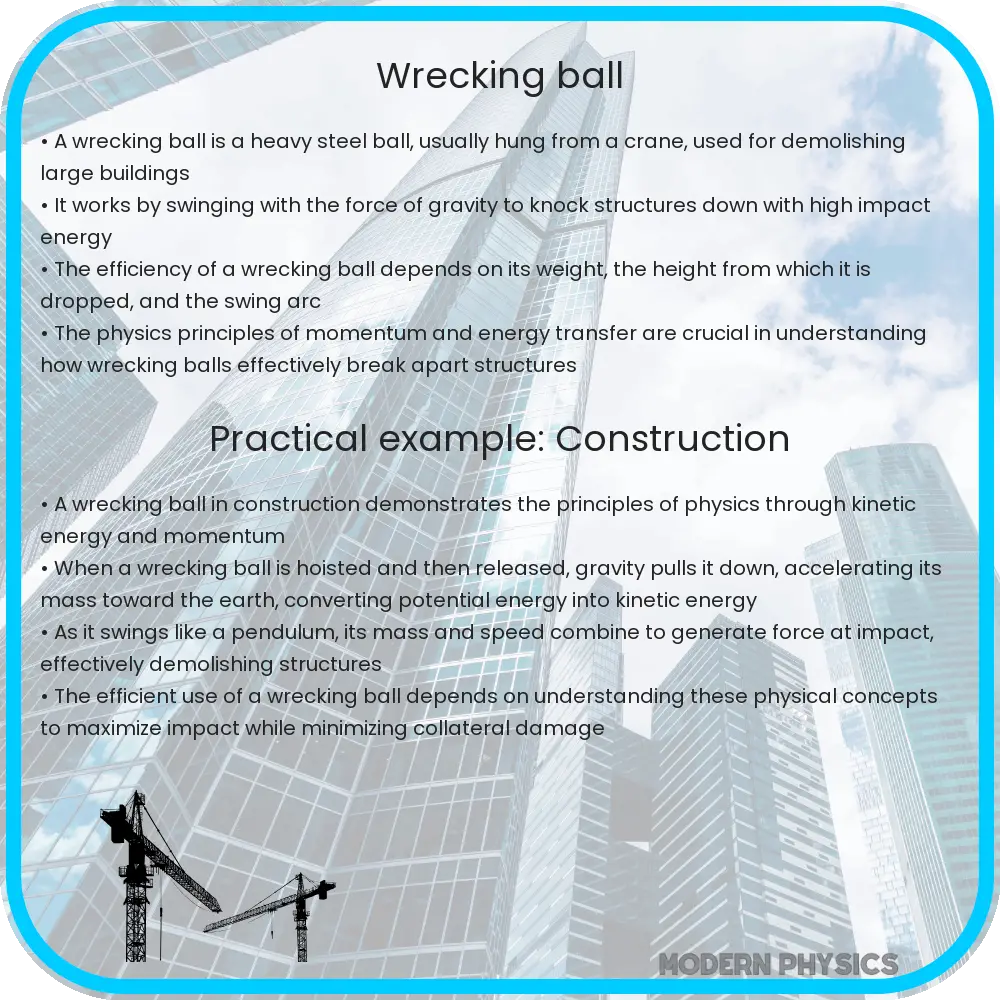The wrecking ball, an iconic tool in demolition, operates on fundamental physics principles. Its efficiency in breaking down structures is rooted in the concepts of force, impact, and motion dynamics.

Understanding Wrecking Ball Mechanics: The Science of Demolition
The wrecking ball, an iconic tool in demolition, operates on fundamental physics principles. Its efficiency in breaking down structures is rooted in the concepts of force, impact, and motion dynamics. This article delves into the mechanics behind the wrecking ball, offering insights into how it leverages these principles to effectively dismantle buildings.
Force and Impact: The Key Elements
At the heart of a wrecking ball’s functionality is the concept of force. Force, defined as mass times acceleration (F = ma), is what imparts the wrecking ball its destructive capability. The mass of the ball, often several tons, combined with the acceleration due to gravity and the swing, results in a considerable force upon impact with a structure.
Impact, on the other hand, relates to the collision between the wrecking ball and the building. The force of impact depends not only on the ball’s weight but also on its velocity at the moment of collision. The higher the velocity, the greater the impact force. This is governed by the formula: Impact Force (Fi) = Mass (m) x Velocity2 (v2)/ Distance (d).
Motion Dynamics: The Swing
The motion of a wrecking ball is a classic example of pendulum motion in physics. When suspended from a crane, the ball swings in a wide arc, its path governed by the principles of pendular motion. The kinetic energy (KE = ½mv2) of the ball at the lowest point of the swing is at its maximum, making this the point of maximum impact force.
Additionally, the height from which the ball is released also plays a critical role. The potential energy (PE = mgh, where h is the height) at the starting point is converted into kinetic energy as the ball swings down. This conversion underscores the interplay between potential and kinetic energy in determining the impact force.
The angle of the swing, typically controlled by the crane operator, also affects the wrecking ball’s effectiveness. A wider swing results in a higher velocity at the point of impact, thereby increasing the force exerted on the structure.
Material and Design Considerations
The material and design of the wrecking ball are crucial for its effectiveness. Typically made of dense materials like steel, the ball must be heavy enough to generate substantial impact force but not so heavy as to be unmanageable. Its spherical shape helps in minimizing air resistance and concentrating the force of impact on a small area, enhancing its destructive power.
In summary, the wrecking ball’s efficiency as a demolition tool is a testament to the application of basic physics principles. Understanding these principles not only aids in appreciating this demolition method but also in optimizing its use in various construction scenarios.
Advanced Dynamics: The Role of Elasticity and Momentum
The wrecking ball’s impact is also influenced by the concepts of elasticity and momentum. Elasticity refers to how the energy is absorbed and redistributed upon impact. A more elastic collision results in a greater rebound of the wrecking ball, reducing the energy transferred to the structure. Conversely, inelastic collisions, where the ball and structure deform, lead to more energy absorption by the structure, enhancing the demolition effect.
Momentum, defined as the product of mass and velocity (p = mv), plays a crucial role too. Conservation of momentum principles dictate that the total momentum before and after the collision remains constant, assuming no external forces. This conservation helps in predicting the aftermath of the wrecking ball’s impact on different structures.
Structural Responses and Safety Considerations
Understanding the response of different materials and structures to wrecking ball impacts is vital for effective and safe demolition. Structures made of brittle materials like concrete tend to shatter, while those with ductile materials like steel may bend or warp. The design of the structure, including factors like load-bearing walls and support beams, also influences how a building will collapse.
Safety is paramount in wrecking ball operations. Proper planning, including assessing the structure’s stability and determining the optimal swing angle and height, minimizes risks. Surrounding areas must be cleared and secured to prevent accidental damage or injuries.
Environmental Impact and Alternatives
While effective, wrecking ball demolition has environmental implications. The process generates significant debris and dust, which can be hazardous. Modern alternatives like hydraulic excavators and controlled explosions are sometimes preferred for their precision and reduced environmental impact. However, in certain scenarios, the wrecking ball remains the most viable option due to its simplicity and cost-effectiveness.
Conclusion
The wrecking ball, a symbol of raw destructive power, is a marvel of engineering that elegantly applies fundamental physics. Its effectiveness lies in the interplay of force, impact, motion dynamics, and material properties. While its use has diminished with the advent of more precise demolition techniques, its legacy in the field of construction and demolition remains significant. Understanding the science behind this tool not only enlightens us about its past and present uses but also provides a glimpse into the intricacies of physics in practical applications. The wrecking ball, in its simplicity, exemplifies how basic scientific principles can be harnessed to achieve remarkable feats in engineering and construction.
